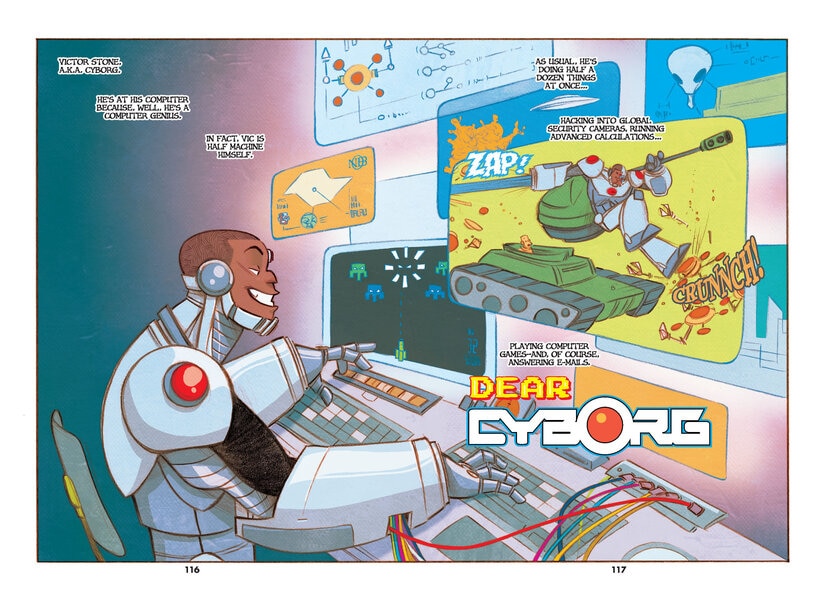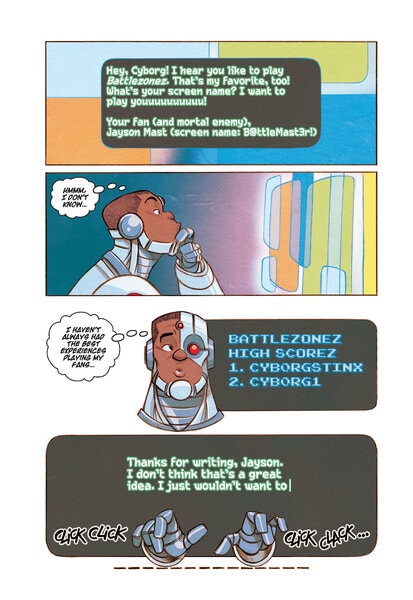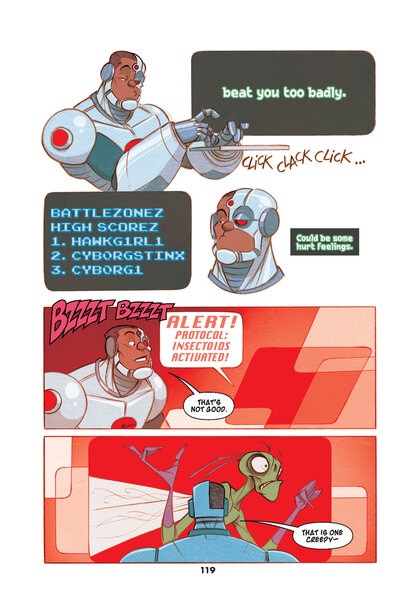Create a free profile to get unlimited access to exclusive videos, sweepstakes, and more!
How Dear Justice League's creators crafted a gateway comic for kids
DC Comics' Zoom Imprint is an initiative to get younger readers into reading graphic novels, capitalizing on the market that has grown following the success of quality selections in the Scholastic book fairs and book clubs. It was kicked off with Super Sons: The Polarshield Project, written by Ridley Pearson and drawn by Ile Gonzalez, but while a Super Sons sequel is in production, a new offering aims for an even larger audience.
DC teamed Sports Illustrated Kids journalist Michael Northrop with Brazilian superstar artist Gustavo Duarte (Bizarro, Monsters and Other Stories) and colorist Marcelo Maiolo on Dear Justice League, a collection of eight loosely connected stories, each featuring an interaction between one of the members of the Justice League and one of their fans. It is an immediate crowd pleaser, with the kind of art that will melts the hearts of readers, and a sample of it was available at this past Free Comic Book Day.
SYFY WIRE has an exclusive preview of the book and an interview with the creators, which you can read below!
There are a variety of ways to tackle the issue of fostering young readers to books and how comics can be a gateway. Talk about your approach to coming up with a story or concept for Dear Justice League.
Northrop: We both relied on the funnier, kid-friendly versions of these characters that we grew up on. We both loved Super Friends, and for me, Richard Donner's Superman movies. Today, comics are darker, but since this was for a middle-grade audience it was easy to go back to those early touchstones where Batman and Superman were a little more earnest, a little more positive, and a little less dark.
Michael, I know that you come from a sports journalist background. Was there a correlation between how kids want to speak to these larger-than-life sports athletes and kids wanting to talk to Batman or Superman?
Northrop: The time I spent at Sports Illustrated Kids was really where the idea came from. I interviewed a lot of athletes, and the questions that almost always got the best response were not the ones I came up with, but the questions that came directly from kids. The athletes came across as less guarded and less defensive that they were used to being with adult journalists, so there was less room for gotcha journalism. It was eye-opening to see how much athletes let their guard down and answered a little more openly and honestly when the questions came directly from a kid than one of our own reporters. It was something that inspired this book and guided me. On the outside, they're larger than life, but on the inside, they're regular people trying to do their best. If there's an opportunity to let their guard down, you can see that.
You made sure not to stray into the kind of negative territory you'd find when a Kevin Durant or Megan Rapinoe feels the need to answer their critics.
Northrop: The Internet giveth, and the Internet taketh away. What we say is that everyone is just a tweet away. We also thought of the downsides, like the minor superheroes didn't get a blue check mark; Batman has one, Superman, a check mark, but [laughs] sorry, Beast Boy, you didn't make the cut. It's funny to think of stuff like that with everybody online all the time, but this for this book, I tried to focus on the positive aspects of that 24/7 access and not get too deep in the weeds. Maybe we'll get into the negatives with the Dear Super Villains book.
Ridley Pearson took more of a narrative approach with Super Sons, while you took more of a vignette, anthology approach. Given the target audience, did you think your concept would go over better as shorter stories?
Northrop: I don't know if it would be more successful, but I did think it would be more accessible. For me, it's more entry points, whether it's a younger reader or a more selective reader who wants to just pick out their favorite character as a starting point, even if it's the middle of the book. Like, if someone is a Wonder Woman fan, they can start with her story first and if they like it, stick around and check out other parts of the book. We went for shorter chapters, some humorous, others a little more serious, but we wanted to offer more entry points for a wider range of kids. I definitely put a through line in there for people reading cover to cover, but I want it to make it as accessible to as many people as possible.
Why is that?
Northrop: I'm dyslexic, and was reluctant as a reader growing up. I repeated a grade and spent time in special education, and for years I read the bare minimum. It seemed like something that was not meant for me. I remember trying to read the shortest novels I could find, and I would feel so proud reading a 150-page novel, but it still counted. I felt so good about having read and finished a book, but I did take the low-end fruit. So I thought about Dear Justice League being accessible to as many kids as possible and chopping that up into short sections as some of the things that could have kept me in, at that age.
I struggled with reading as a kid; it wasn't until high school, when comics came along, that I was brought back to an encouraging path of reading.
Northrop: That first section of the book, the Superman chapter for the most part has no words, just sound effects with a lot of physical comedy. I did that intentionally, to make it as comfortable as possible. That was me, too. Comics were the first thing I could read along with my friends. They were much faster readers than me, and more willing readers than me, but comics with the visual storytelling, I could read it at the same time as everyone else was, and I could join in on the discussions in the back of the bus. That was the first time I was included, reading not only for fun but in a social gathering.
Gustavo, did you connect to the DC middle grade initiative of using comics/graphic novels to pull in non-readers or kids who struggle with reading? Was being able to help in that department a draw for you to be involved?
Duarte: I like to draw comics for everybody, including comics for people that don't normally read comics or have yet to discover comics, like kids. I remember falling in love with comics as a kid, but I've noticed that a lot of kids don't read comics these days. They have the superhero T-shirts, toys, etc. but they don't have access to the stories and books that these heroes are known for.
A lot of older comic book readers claim that "comics aren't only for kids," and they're right: Comics are for everyone but especially kids. I love that DC's new books present stories for every type of comic book reader. So when DC called me to work on Dear Justice League, I was really happy and excited. It's a pleasure and a great responsibility to present these iconic characters to a new group of readers, as other creators did for me when I was a kid.
You've played with superheroes before on Bizarro and Lockjaw for Marvel, but your designs are so adorable, toeing the line of cartoony and children's books and animation. How long did you work on your Dear Justice League designs, before getting your final look?
Duarte: I really love to lean towards the cartoony/animation design path. Cartoons and animated movies are huge influences on my development as an illustrator and cartoonist. I really had a great time working on the character designs for Dear Justice League, which took me about a month to finalize.
Michael, this is the first time you have created a comic book and worked with an artist, collaborating together. How was the collaborative process?
Northrop: It was a fun process, it was new for me and a learning process. I don't know how much you'll remember this, Gustavo, but the early pages I handed in were a little more detailed as far as body position, and as I started getting pages in, I realized how much we were on the same page with our ideas for DC heroes and the story, and I just got out of the way a bit. I trusted Gustavo to be with me on everything, but I liked being surprised, too, with what he brought to the page. I didn't know what to expect at first, but quickly I became comfortable.
Duarte: I had worked with other writers, already, but when I started receiving the first pages of script from Michael, I knew exactly what he was saying. Early on he was describing a lot, but he started to feel more comfortable writing to another collaborator. It's good work when working with a nice script, and Michael's script was real good.
Northrop: It was a very direct and fun way to communicate about the pages. The idea of this book is, superheroes are people, too. I could try and write situations to make that clear, but he could do one little raised eyebrow or insecure expression and communicate that same thing right there.
Duarte: We were on the same page when it came to the humor, how much fun it would be to show the kids. A lot of times when you are doing a book for kids, there are a lot of restrictions on what we could and could not do, whether it was a kid shouting, fighting, etc. This book was not that. It's how I understand books are for kids, and it helps working with Michael.
Gustavo, did you have a particular hero that you wanted to interact or relate to?
Duarte: I never did when I was a kid, but nowadays the 42-year-old Gustavo would ask Batman how he gets everything in his little bat-belt. How can he fit Bat-a-rangs and everything else in this tiny belt?
The question to Wonder Woman interested me, because she actually put herself in herself at the age of one posing the question. She's the only one to do so. Why was that?
Northrop: We had eight shots to tell a story, and we wanted there to be a mix, to be different for everybody. Not just about these kids wondering about these adults, but also the heroes thinking about their own childhoods. Wonder Woman was a fun opportunity for that, because her childhood was on Themyscira. You could have her relating in a direct way, but it was still fun and out there.
Duarte: This is one of my favorite parts of the book, because I could draw Wonder Woman as a woman, but also as a kid, like a new character, Lil' Diana. It was nice to just create her without referencing something else.
Finally, we get a glimpse of the sequel, Dear Super Villains, in the back of Dear Justice League. That can't be a mirror to this series, because kids aren't necessarily idolizing villains, right?
Northrop: The first thing I started thinking about exploring that was the fascination we have with the bad guys. Gustavo also watched Super Friends, and the Hall of Doom would emerge from the swamp, and I would sit up a little closer and think, ooooh, these are the bad guys. It's a little dangerous. I wanted to get some of that thrill, but also, it's going to be a safe walk on the wild side. We'll see a contrast of heroes working together and villains out for themselves. Maybe we'll see the consequences of some bad decisions. I want it to be bad enough that it's exciting and fun but good enough that it's still in that wholesome Dear Justice League family.




























